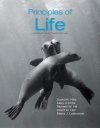About this book
For instructors concerned that the practical skills of biology are lost when the student moves on to the next course or takes their first step into the "real world", Principles of Life, third edition, lays the foundation for later courses and for students' careers. Expanding on its pioneering concept-driven approach, experimental data-driven exercises, and active learning focus, this book introduces features designed to involve students in mastering concepts and becoming skillful at solving biological problems.
Research shows that when students engage with a course, it leads to better outcomes. Principles of Life is a holistic solution that has been designed from the ground up to actively engage students in mastering concepts and becoming skilled at solving biological problems. Within LaunchPad, the publisher's digital teaching and learning solution, thoughtfully curated assignments and activities to support pre-lecture preparation, classroom activities, and post-lecture assessment can be assigned.
With its focus on key competencies foundational to biology education and careers, self-guided adaptive learning, and unparalleled instructor resources for active classrooms, Principles of Life is the resource students need to succeed.
Contents
1 Principles of Life
PART 1 CELLS
2 Life’s Chemistry and the Importance
of Water
3 Nucleic Acids, Proteins, and Enzymes
4 Cell Structure and Membranes
5 Cell Metabolism: Synthesis and Degra-
dation of Biological Molecules
6 Cell Signals and Responses
PART 2 GENETICS
7 The Cell Cycle and Cell Division
8 Inheritance, Genes, and Chromosomes
9 DNA and Its Role in Heredity
10 From DNA to Protein: Gene Expression
11 Regulation of Gene Expression
12 Genomes
PART 3 EVOLUTION
13 Processes of Evolution
14 Reconstructing and Using Phylogenies
15* Evolution of Genes and Genomes
16 Speciation
17 The History of Life on Earth
PART 4 DIVERSITY
18 Bacteria, Archaea, and Viruses
19 The Origin and Diversification
of Eukaryotes
20 The Evolution of Plants
21 The Evolution and Diversity of Fungi
22 Animal Origins and Diversity
PART 5 PLANT FORM AND FUNCTION
23 The Plant Body
24 Plant Nutrition and Transport
25 Plant Growth and Development
26 Reproduction of Flowering Plants
27 Plants in the Environment
PART 6 ANIMAL FORM AND FUNCTION
28 Temperature, Energy, Matter,
and Homeostasis
29* Animals in Their Environments
30 Breathing and Circulation
31 Neurons, Sense Organs,
and Nervous Systems
32 Control by the Endocrine
and Nervous Systems
33 Muscle and Movement
34 Animal Reproduction
35 Animal Development
36 Immunology
37 Animal Behavior
PART 7 ECOLOGY
38 Ecological Systems in Time and Space
39 Populations
40 Interactions within and among Species
41 Ecological Communities
42 The Global Ecosystem
Customer Reviews
Biography
David M. Hillis is the Alfred W. Roark Centennial Professor in Integrative Biology at the University of Texas at Austin, where he also has directed the Center for Computational Biology and Bioinformatics and the School of Biological Sciences. Dr. Hillis has taught courses in introductory biology, genetics, evolution, systematics, and biodiversity. He has been elected to the National Academy of Sciences and the American Academy of Arts and Sciences, awarded a John D. and Catherine T. MacArthur Fellowship, and has served as President of the Society for the Study of Evolution and of the Society of Systematic Biologists.
Mary V. Price is Professor of Biology, Emerita, at the University of California, Riverside and Adjunct Professor in the School of Natural Resources and the Environment at the University of Arizona. In "retirement," she continues to teach and study, having learned the joy and art of scientific discovery as an undergraduate student at Vassar College and doctoral student at the University of Arizona.
Richard W. Hill is Professor in the Department of Zoology at Michigan State University and a frequent Guest Investigator at Woods Hole Oceanographic Institution. He received his Ph.D. in Zoology from the University of Michigan.
David W. Hall is an Associate Professor of Genetics at the University of Georgia, where he was the recipient of the Sandy Beaver Excellence in Teaching Award in 2013. Recent work includes using mathematical models to address the evolution of meiotic drive, the rate and pattern of molecular evolution in social insects, and early sex chromosome evolution. In the lab, he utilizes different yeast species to study spontaneous mutations using a combination of both mutation-accumulation and adaptation experiments. Since high school, he has been captivated by how the living world works. Like many students, he was initially overwhelmed by the diversity of life, but he came to realize that there are fundamental principles that unite organisms. His interest in determining how these principles shape the diversity of life led him into his research and teaching career.
Marta J. Laskowski is a Professor in the Biology Department at Oberlin College. Dr. Laskowski has mentored undergraduate students in research and has taught introductory biology, skills-based first year seminars (Feeding the World), plant physiology, and plant development. She heads an effort at Oberlin, funded by the HHMI Inclusive Excellence program, to enhance the climate for and success of a diverse student population in STEM. One of her numerous journal articles resulted in a Guinness World Record for the fastest opening flower (Cornus canadensis; bunchberry). A college class in developmental biology so captivated her that she decided to focus her research on discovering the intricate sub-cellular interactions that establish the plant root system.



































